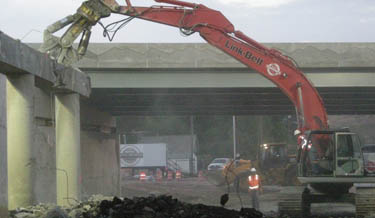InTrans / Jul 01, 2014
The ABCs of putting “drivers first” in bridge projects
Go! Magazine
 posted on July 1, 2014
posted on July 1, 2014
If you were a bridge, chances are pretty good that you’d be at least 50 years old and seriously showing your age. A significant portion of the U.S. roadway system was built more than 50 years ago. After that length of time under traffic, many roads and bridges are deteriorating. Plus, many of them were built to standards that are now out of date. That is, they were built for the traffic and conditions of another era, not for 21st century vehicles and needs. As a result, of the 600,000 publicly owned bridges in this country, one out of every four is either “structurally deficient” (based on their condition) or “functionally obsolete” (based on current standards).
Bottom line: A whole lot of bridges need to be either repaired or reconstructed or replaced. There are many challenges involved in major bridge projects. One big challenge is finding ways to reduce the inconvenience to motorists caused by such projects. Traditionally, bridge construction requires work zones or even temporary road closures. In 2003, one of every five miles of the nation’s highway system was affected by a work zone. That’s a serious problem for travelers. Work zones and road closures slow and/or redirect traffic—sometimes for weeks or even months. They can contribute to traffic congestion and safety issues. Drivers are impatient with the related delays and other inconveniences.
“The majority of us have experienced the frustration of traffic congestion while driving through a construction zone, one or more lanes are closed with no apparent construction activities in sight!” said Ahmad Abu-Hawash, chief structural engineer at the Iowa Department of Transportation. “ABC ensures that road closures are kept to a bare minimum. The intention is to GET IN, GET OUT, and STAY OUT. With this approach, you enhance mobility, improve safety, and at the time you improve public perception.”

Drivers first
The agencies that own roads and bridges are looking for ways to reduce the hassles and potential dangers for motorists related to construction. As an example, in 2012 Governor Andrew Cuomo of New York announced a new initiative called “Drivers First.” Its goal: Make driver convenience a priority at road and bridge construction sites across the state. The focus: Ensure that disruptions to traffic are as brief as possible. “Our job is not to have people adjust to government,” Cuomo said, “but to have government adjust to the people.”
The ABC strategy
One way that agencies across the country are implementing a “drivers first” philosophy on bridge projects is by adopting Accelerated Bridge Construction (ABC) practices. Accelerated Bridge Construction practices decrease the time required to construct a bridge. In particular, most ABC technologies focus on reducing the time that travelers are affected by construction activities. One example of ABC is constructing a bridge “off alignment” (that is, not in place) and then sliding it into its permanent location using a self-propelled modular transporter. While the bridge is being constructed, the roadway stays open to traffic, and traffic is unimpeded. The road is closed to traffic only for the relatively brief time required to slide the bridge into place. (See a related Go! article, Massena Bridge Slide.) Accelerated building practices like slide-in bridge construction can reduce the duration of work zones. In addition to fewer and shorter traffic disruptions and delays, there can be other benefits. Some of these include fewer construction-related traffic accidents and less tailpipe emissions related to vehicle idling. Some ABC projects may reduce overall costs.
Challenges related to ABC
Nationally, the traveling public isn’t experiencing the full benefits of ABC. In some cases, agencies haven’t yet adopted ABC technologies or processes. In other cases—for example, in areas prone to high seismic activity/earthquakes—there are technological or logistical obstacles to ABC. Finally, ABC technologies are still being developed. Because of the urgent need to replace substandard bridges, ABC is currently focused primarily on bridge replacements. Soon, however, projects to repair and renew older bridges will dwarf projects to replace them. Additional ABC technologies related to repair and rehabilitation are needed. A recently formed University Transportation Center (UTC) is focusing on the development and deployment of ABC technologies and policies. The new ABC-UTC conducts research, education, and technology transfer that will ultimately lead to more widespread use of ABC—all with the ultimate goal of putting drivers first. One activity of the new ABC-UTC is this new series of articles—The ABCs of putting “drivers first” in bridge projects—written exclusively for Go!. The series will introduce the variety of innovative ABC advancements being implemented across the country.
Related links
Press release re: New York State’s “Drivers First” initiative: https://www.governor.ny.gov/press/09272012Drivers-First
See the other articles in this series:
“The many faces of bridge engineering”
“Build bridges faster—but can you keep them together?”
“Accelerated bridge construction—constructability is KEY!”
ABC-UTC homepage: http://www.abc-utc.fiu.edu/
Federal Highway Administration initiative to promote ABC (scroll to bottom of page for videos, photos, and more): https://www.fhwa.dot.gov/everydaycounts/edctwo/2012/abc.cfm
By Brent Phares, Bridge Engineering Center, Iowa State University